The Linguistics Space (II) --- the Intelligence
Copyright © May 2010 by Tienzen (Jeh-Tween) Gong
In the paper "The Linguistics Space (I) -- the Life System," I stated that linguistics is isomorphic to intelligence. That is, all (each and every) things which can be handled by intelligence can be described linguistically. By knowing linguistics, we should know everything about intelligence, and vice verse. However, a person can act one way in the office and another way at home. Thus, "intelligence" can still have a different expression from linguistics, as one of the two sides of the same coin. After all, the two sides can have different expressions.
I. About Intelligence
I will not define that what "intelligence" is with any terms. I will defined it by working on some intelligent tasks and, thus, to show that what intelligence is in the process. I am using a well-known problem in AI (artificial intelligence), the Bongard problem, as the example. The following is a chaotic system with only 36 (a very small number) members.
a. A Small Chaotic System
A chaotic system with 36 members
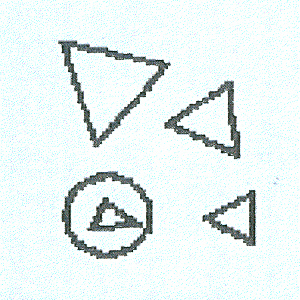 |
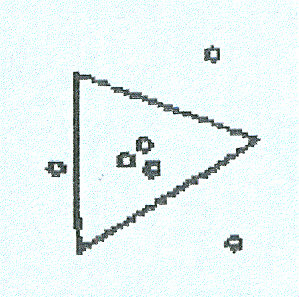 |
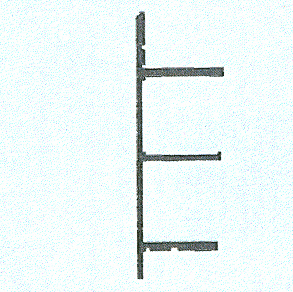 |
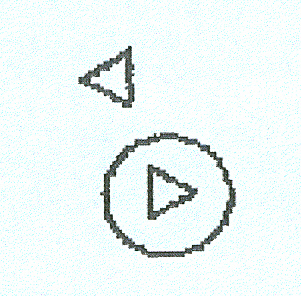 |
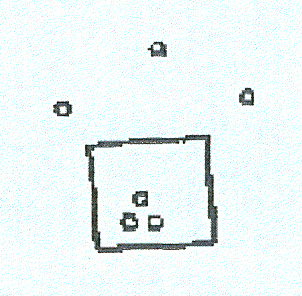 |
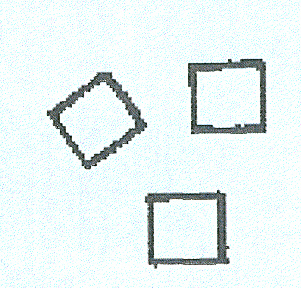 |
 |
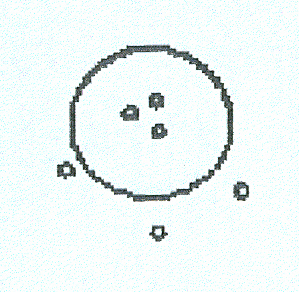 |
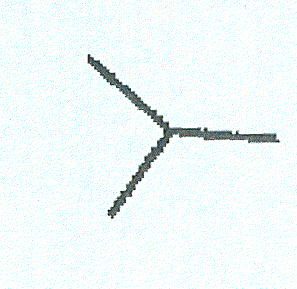 |
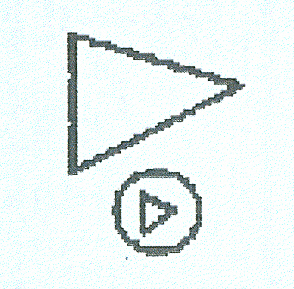 |
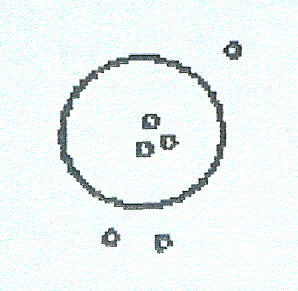 |
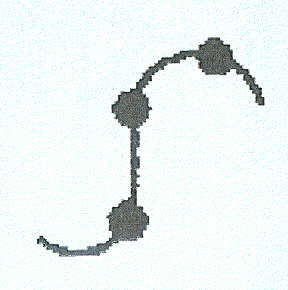 |
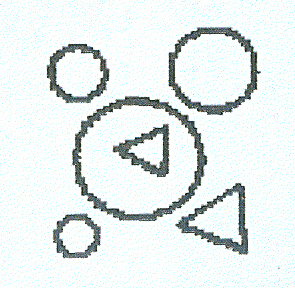 |
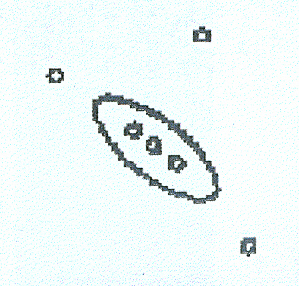 |
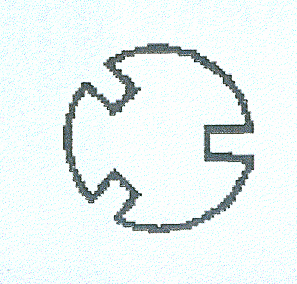 |
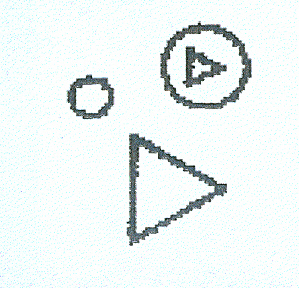 |
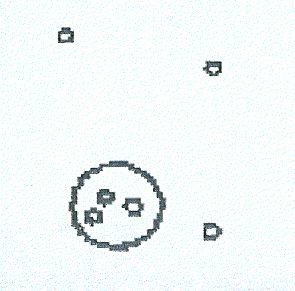 |
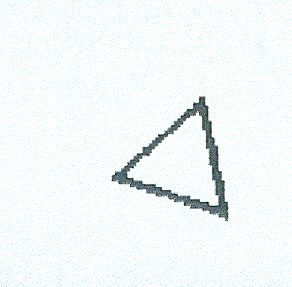 |
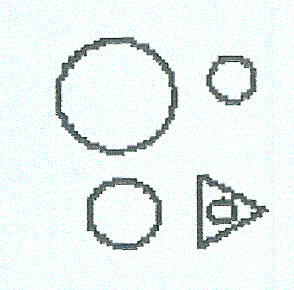 |
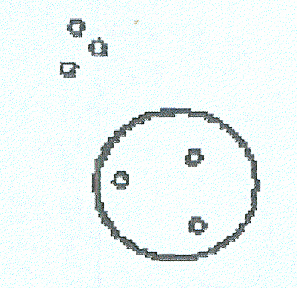 |
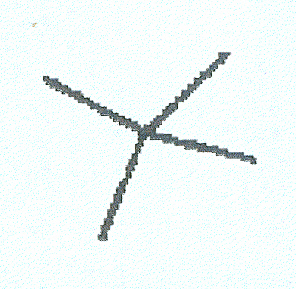 |
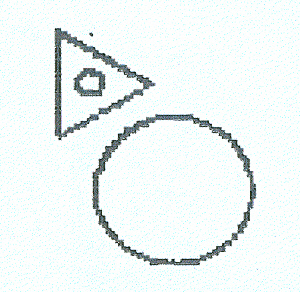 |
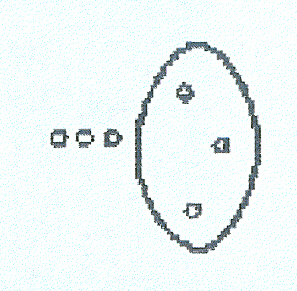 |
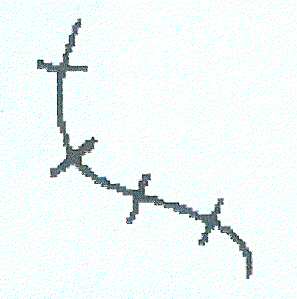 |
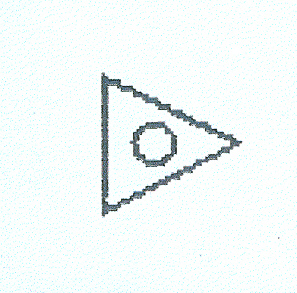 |
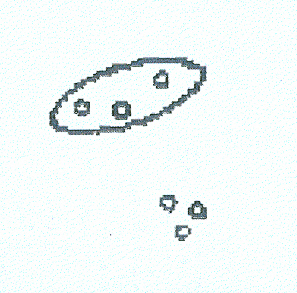 |
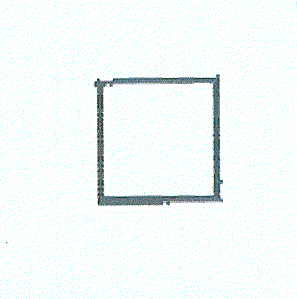 |
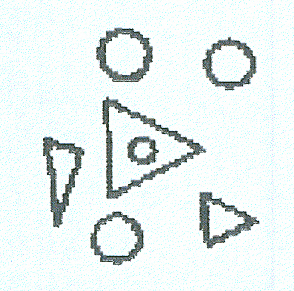 |
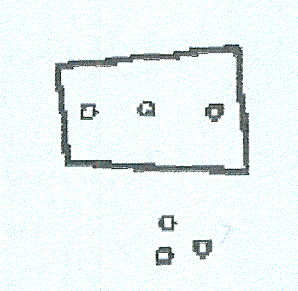 |
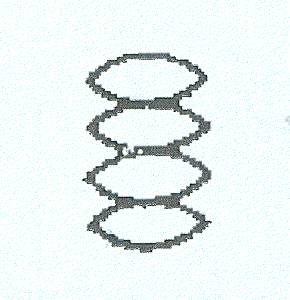 |
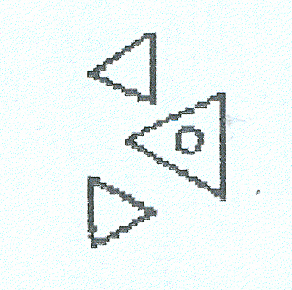 |
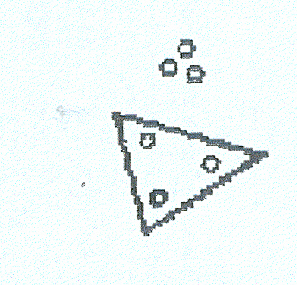 |
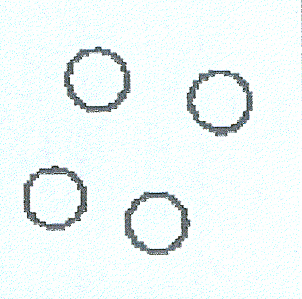 |
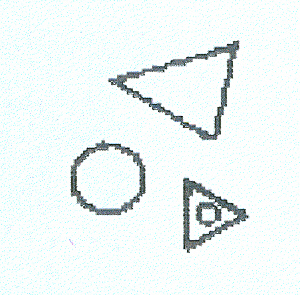 |
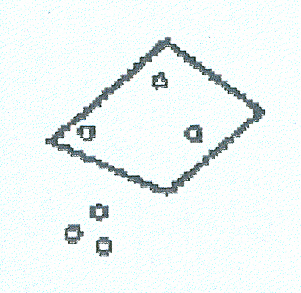 |
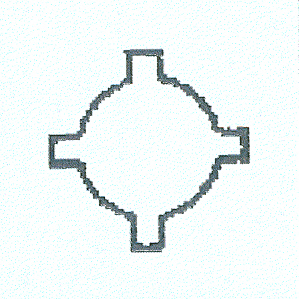 |
b. The Acts of Intelligence
As you (the reader) are an intelligent being and facing a very small system above, what are you going to do (the interaction between an intelligent being with an arbitrary system)? Nothing, it will be fine, and your intelligence is simply inactive. If you are willing to do something, then what? What does your intelligence want to do with this system?
Now, we know that an "active" intelligence must have an "intention", wants to do something.
But, doing what? With the above example, a fun thing could be trying to find some orders in it.
- Let us start with the graph (1, 1). It has three triangles and one circle which encloses one triangle. By a choice, I would like to see whether or not any other graphs also have this special feature, a circle enclosing a triangle. By simply scanning all graphs, I will find five more of them.
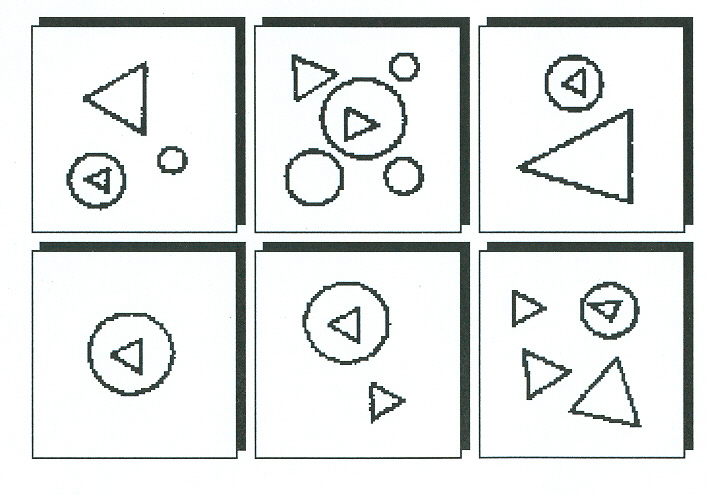
- Now, let us look at the graph (1, 2). It has three little "o"s spreading around a figure. Again, are there other graphs also having this feature? Here, they are.
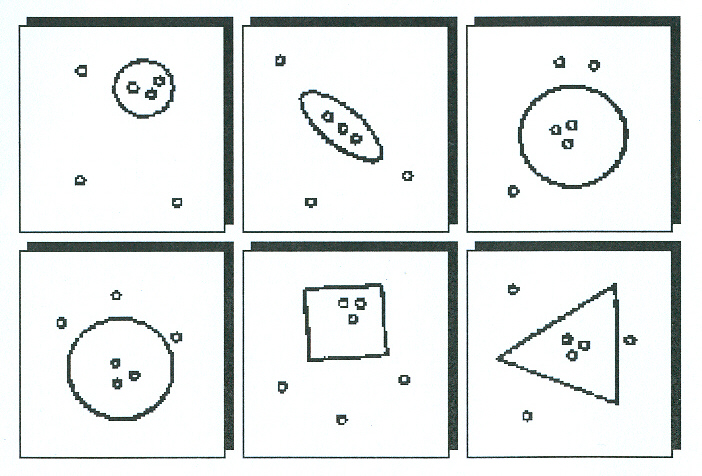
- How about the graph (1, 3)? It has three identical lines and .... If we choose the "three identical" as our searching criterion, the following is our answer.
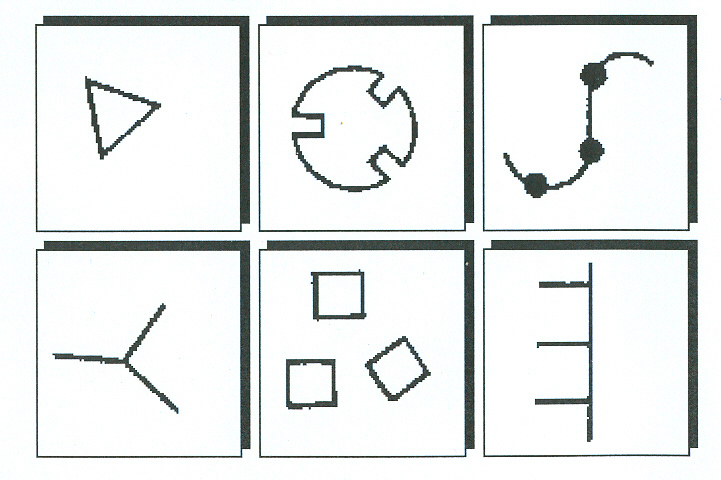
Then, we can easily group the remaining graphs into three more groups with the above procedure.
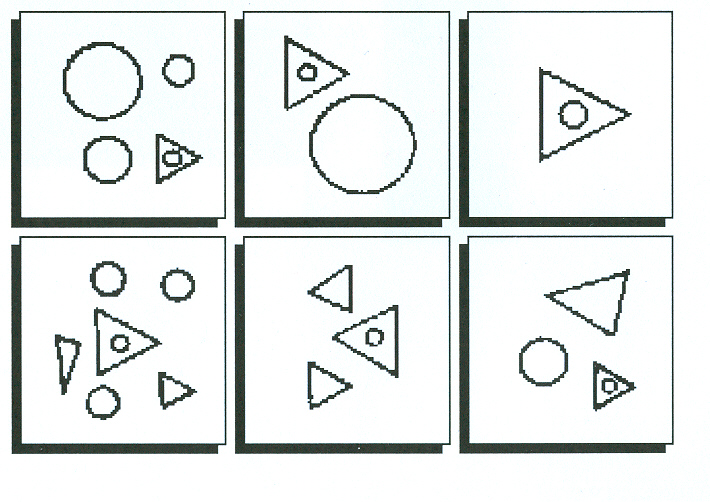
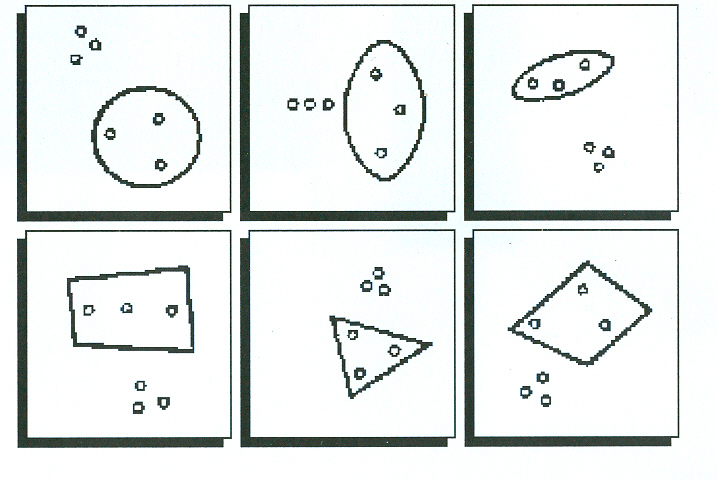
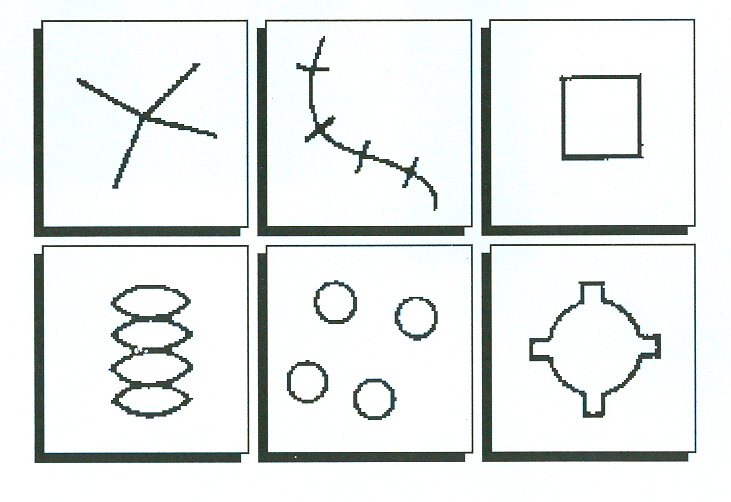
Now, we have organized the chaotic system of 36 members into a six group system. Can we reduce it any further? What should be the criterion for this further reduction? Any arbitrary grouping can be done without any intelligence. The "smart" way will be to group them if they are similar while also different. With this criterion, the 6 groups can be further reduced into three groups, as below.
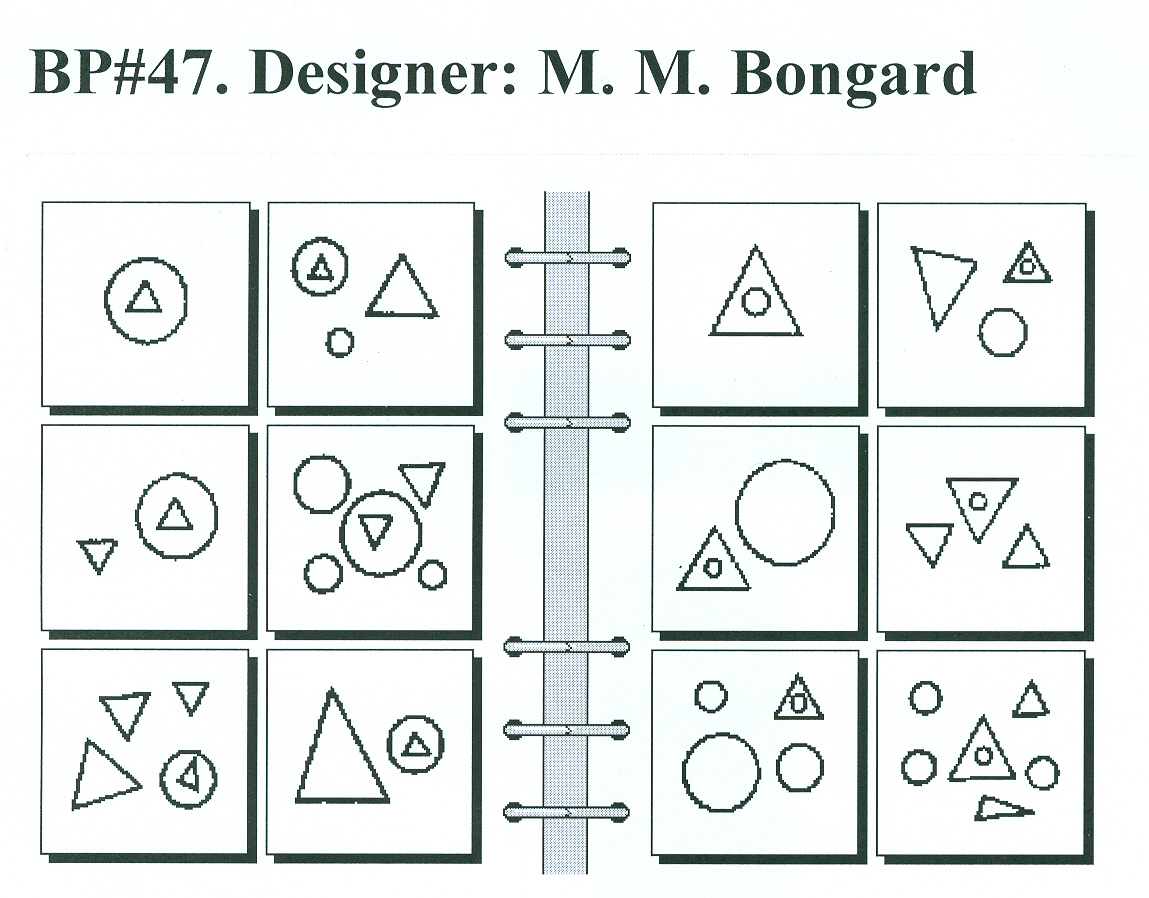
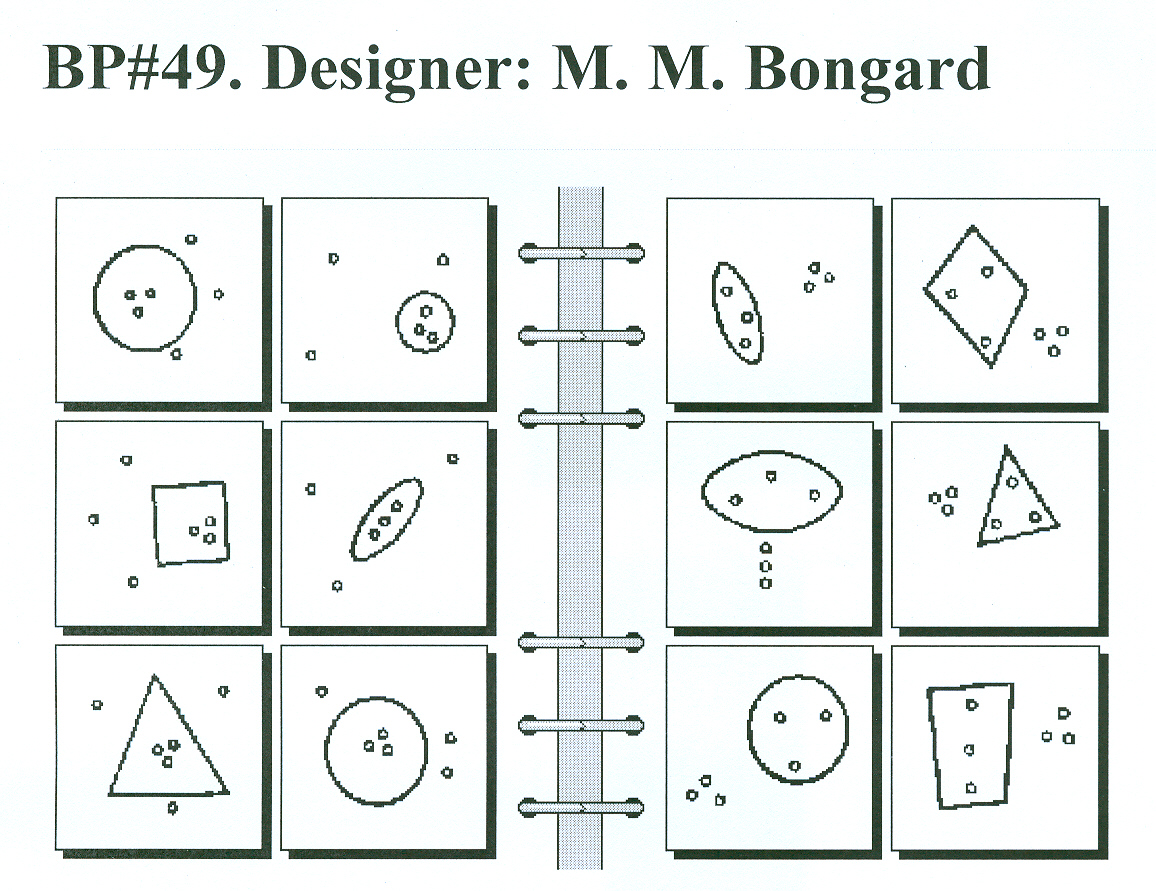
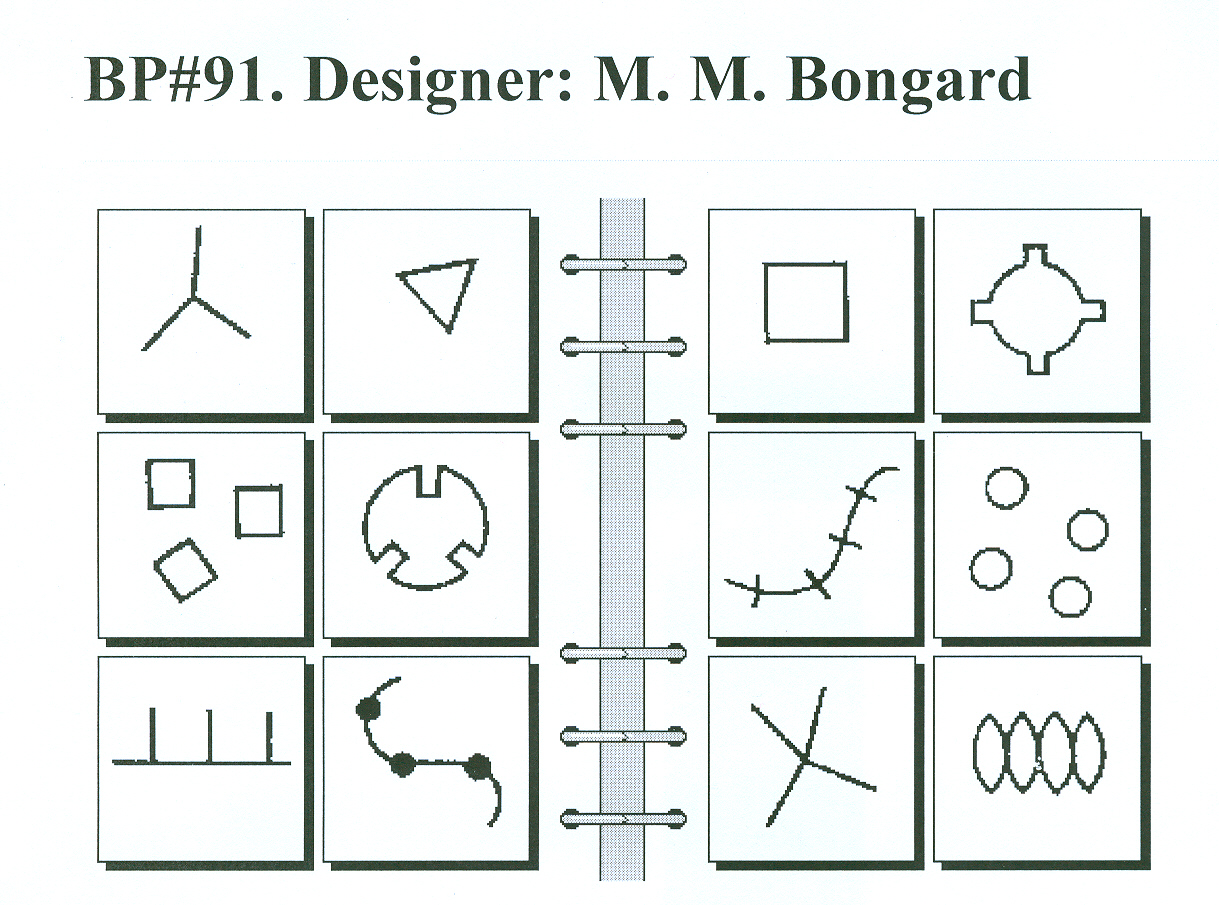
These three are the well-known Bongard problems --- what is the major difference between the left group from the right? I will not give the answers of them here. In fact, the readers should already know those answers by now. That is, the answer of any problem is embedded in the manifestation process of that problem.
II. Intelligence Exactly, Here It Is
With the above exercise, we, now, know exactly what the intelligence is.
- It must be an intention. Any intelligence which has no intention is not intelligence.
- There must be some tasks for that intention.
- There must be some methods to accomplish those tasks.
Now, many AI programs can perform many intelligent tasks. But, they are not intelligence if the intention of performing those tasks is not spontaneous from the programs. Any well-defined intelligent problems or tasks can always be carried out with a formal system procedure which is mechanic, not intelligence. Thus, the intelligence must be,
- a spontaneous intention.
- some tasks identified by that spontaneous intention.
- some methods to accomplish those tasks.
When an intelligence encounters with one situation, it has only two choices, does nothing or does something. However, if there are millions ways of identifying the tasks of a situation and millions methods of accomplishing these tasks, then the chance for us to reproduce intelligence (as AI) is not very good. On the other hand, if these two issues are as simple as 1, 2 and 3 for all situations, then AI is definitely possible.
In fact, there is one and only one task for "any" intelligence, finding "orders" from a situation. And, there is one and only one method to perform the above task, finding the "commonality" among differences. These facts not only allow the rising of intelligence but make AI possible.
From the above example, it is very clear that the commonness and the difference are mutually immanent to each other. By "only" finding the commonality, the differences are sieved out automatically. An invading virus must find a host's enzyme which is "similar" enough to its own to begin the process of replicating its own DNA for a successful invasion.
And, the sole task (finding some orders) of any intelligence is to construct a FGL system (Formal, Godel and Life system) for any situation of which it encounters. Thus, this task of intelligence is identical to the task of linguistics, which is described in detail in the paper "The Linguistics Space (I) -- the Life System," available at http://www.prebabel.info/lifesys.htm.
III. Types of Intelligence
a. Zombie Principle and the Intuitive Intelligence
In fact, there are two types of intelligence. For every well-defined intelligent task, it can always be carried out with a corresponding "formal system," which can be wholly processed with a computer program. This kind of intelligence becomes a zombie as soon as such a program is written. Now, we have a zombie principle.
Zombie Principle -- there is intelligence which is not reachable by zombie.
One such an intelligence which evades the capture by zombie is the intuitive intelligence. From our previous discussion, every system (however chaotic it is) can always be formalized wholly or partially. Thus, by definition, the intuitive intelligence cannot easily be "wholly" formalized. It has some parts which evade the formalization, and it has, at least, the following capabilities.
- It can get a correct answer 95% of the time while 50% or more of the relevant data is lacking.
- It can get a correct decision 95% of the time while 50% of the relevant answers are unavailable.
Currently, there are some probabilistic and statistical methods for learning and uncertain reasoning, such as, Bayesian network or hierarchical temporal memory method. However, they are all formal systems; a zombie that is.
- It can go against the formal reasons.
- It can make choice among contradictions.
- etc..
In fact, the human intelligence consists of three parts,
- Formal system -- logic and computable. A brute force computation can always perform this task.
- Consciousness -- an awareness of the boundary between a self and others. This awareness arises from,
- a process of ad infinitum self-referential loop (Godel process),
- the process of renormalization which establishes a finitude (a boundary) by terminating the ad infiniteness.
- Free will intention -- behaviors are the outcomes of intentions, and most of behaviors can be achieved by some brute force computation. A pool of intentions (mimic of free will intention) can also be pre-programmed with a bootstrapping learning procedure. Yet, the true free will intention can never be formalized.
b. The Zombie Boundary
During the past 50 years, the zombie boundary has advanced forward with an amazing speed. And that boundary will be significantly different from what we know today ten years from now. However, by reviewing one special case, we can understand the nature of that boundary better.
For playing chess, it is obviously an intelligent task. Yet, today, many chess playing programs can play against a master and win. As a chess game plays on a 8 x 8 universe, its possible moves are relatively small. With a computation speed of over 200 millions moves per second, a program can easily win against a master with such a brute force computation.
For the "Go" game, it will be completely different, with the following differences.
- It plays on a 19 x 19 universe, 5.6 times the size of the chess game.
- Chess has five different pieces with five different moving rules. That is, it is formally heavier than the "Go" which has only one kind of piece (stone) with one rule. Formally heavier system has lesser complexity.
- In chess, there is no local battle. Every move is the battle in the whole board. On the contrary, there can be many local battles in the "Go" game. The "Go" board can be divided, at least, into 9 sections -- 4 corners, 4 edges and the center. The players are playing in 9 or more local battles at the same time.
- The local battle has contradictory nature:
- While the local outcomes can affect the final result, it can play independently from the other areas.
- A local battle can sometimes affect the outcome of its neighboring battle.
- As a formal system, "Go" has only two rules -- a) death upon a complete surround, and b) the ad infinitum situation not allowed. Thus, not too many direct theorems can be developed. Yet, many situations arise via induction, not deduction. The followings are examples of three situations.
- The original situation.
- Black stone goes first.
- There is only one way for black to success.
- The moves for success and fail are listed.
Example 1, Strategy -- extent the breathe
| Original Pattern |
Success |
Fail |
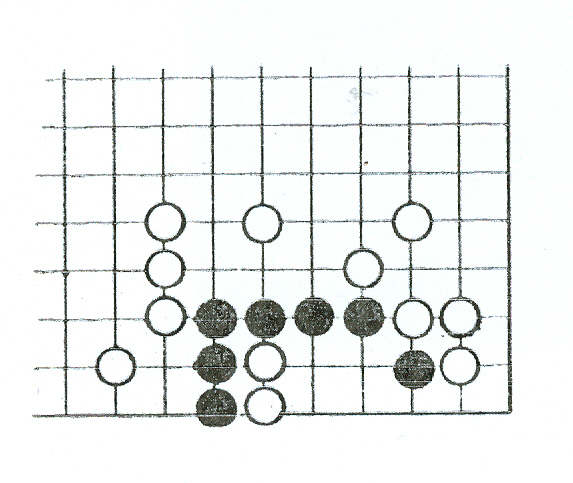 |
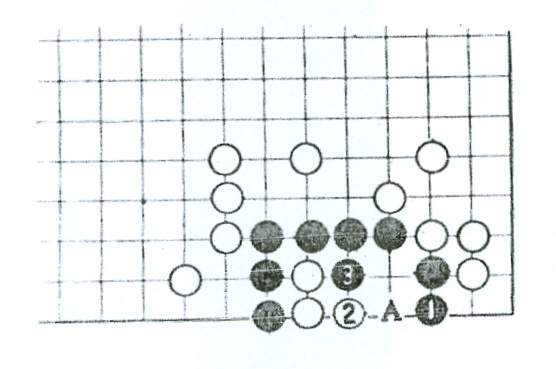 |
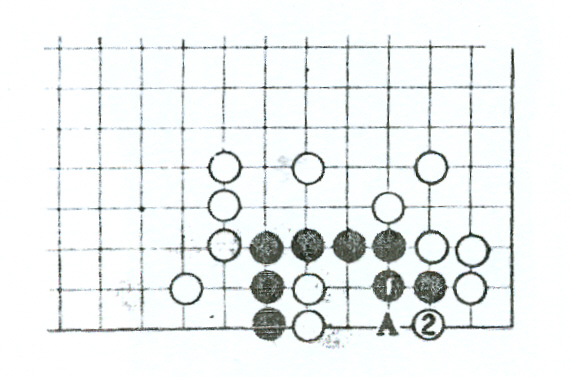 |
Example 2, Strategy -- break the white into two
| Original Pattern |
Success |
Fail |
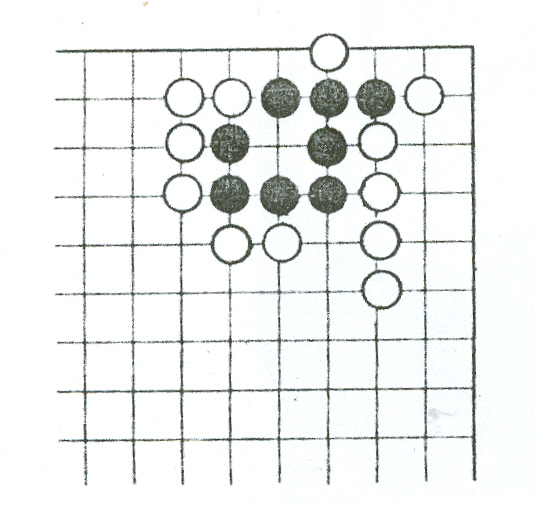 |
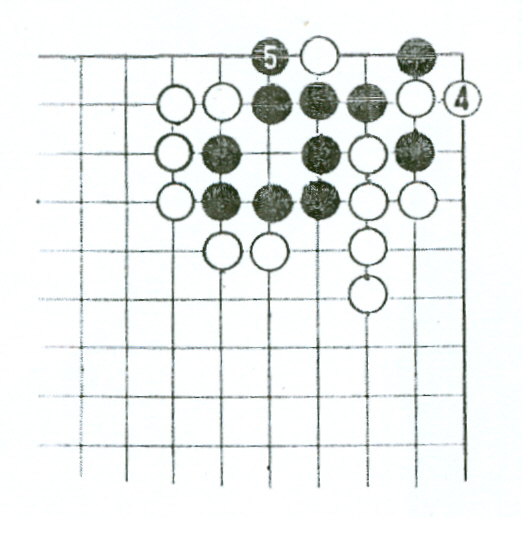 |
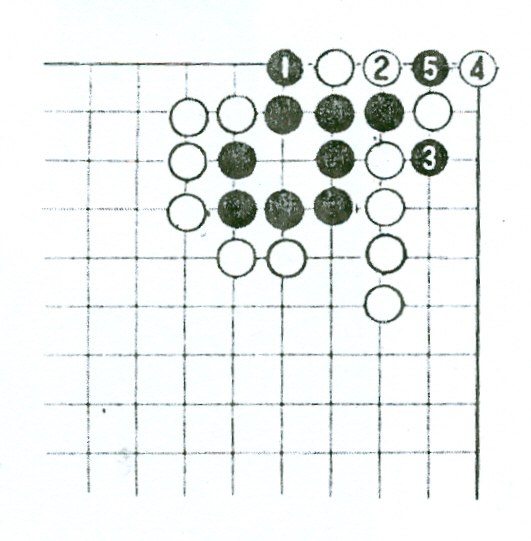 |
Example 3, Strategy -- infiltrate the while area
| Original Pattern |
Success |
Fail |
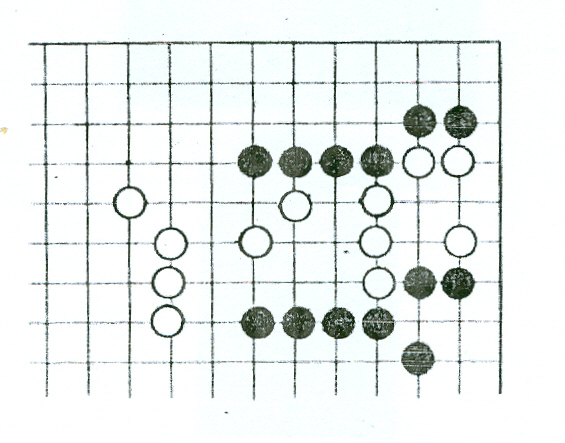 |
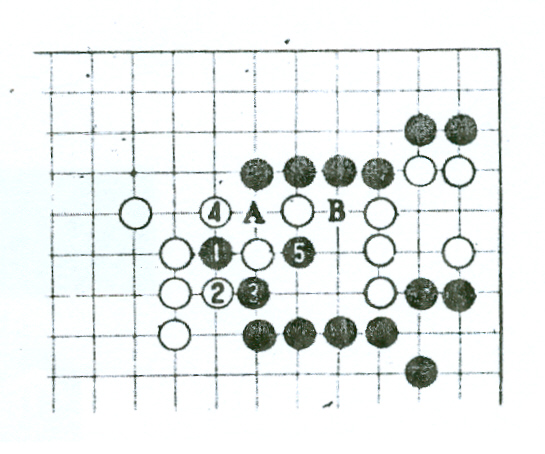 |
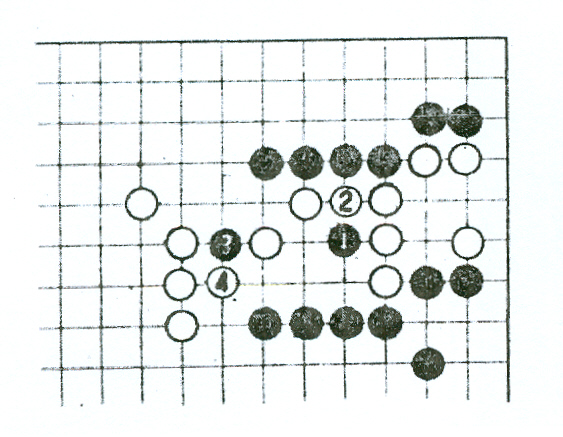 |
There are, at least, 10 different strategies in "Go," and there are thousands of situations for each strategies. There is no formal way to categorize a given situation into what kind of strategy. It can only be recognized intuitively. A master "Go" player must memorize all those tens thousands sample situations.
Although, all those thousands sample situations can be stored in memory for an AI "Go" program, yet, the human player will still have an upper hand as human's intuitive intelligence has a few additional knowledge.
- He can spot a similar situation which is not in the memory.
- He can spot a combined or entangled situation which is not in the memory.
- He can spot the trend of forming a situation which is many moves away.
It will be extremely difficult to "formalize" these intuitive knowledge.
- In "Go," a well planned "suicide move" can, often, change the fortune.
In addition to some "intuitive intelligence" which is very hard to be formalized, the complexity in "Go" is about one billion times of the chess game. Thus, I will use "Go" game as the current zombie boundary. Yet, the key point of this boundary is about that some intelligence is very difficult to be formalized. The meaning of this boundary will become much more clear after we understood the hardware for the intelligence.
IV. The Hardware for Intelligence
a. The Intelligence Process
For the current AI, the hardware is computer with chip and hard disk (HD) memory. For bio-life, the hardware is a brain.
With our understanding on intelligence, as,
- a spontaneous intention for doing a task on any encountered situation,
- the sole task which is to construct a FGL system for that situation and makes a decision with that analysis,
- the sole method for the task which is to find commonality in FGL and in matching it with the objectives of intelligence.
Then, what kinds of Hardware are needed for the above? In FGL, it has the following systems.
- Formal system -- it is computable. So, a computer is needed.
- Godel system -- it is self-referential loops to ad infinitum. The same information is processed in many different ways, that is, it is viewed in many different angles. Thus, a memory is needed to record all these different views.
There are, at least, two tiers for any task.
- analyzing the situation, the FGL(I)
- analyzing a decision, the FGL(II) --- every intelligence has a set of internal parameters. The analysis of FGL(I) will result a set of values from its variables. A decision for the situation can be made by intelligence by comparing the commonality or similarity of these two sets of values.
These form a self-referential loop, and this process can go ad infinitum. However, it will always top-out for an intelligence.
- Life system --
- Contradictions arise in all situations. These contradictions must be evaluated equally. They must co-exist in FGL, that is, mutually immanent to each other. Thus, a mutual immanent machine (mechanism) is needed.
- Many situations encompass infinities and infinite chaos. These infinities and chaos must be renormalized. Thus, a renormalization machine (mechanism) is needed.
Among the AI theories, one of them believes that the intelligence emerges spontaneously from a hierarchy building while the lowest system (and all its members) has no intelligence. Yet, all (each and every) hierarchies of the world are built by self-referential loops or the similarity transformations of fractal, without an exception.
For example, a car factory has many tiers of hierarchy.
- All parts and machines are for the making of cars.
- All workers are for the making of cars.
- All managers are for the quality and production of cars.
- All VPs are for the managing the finance of making cars.
- All shareholders are for the profit from making the cars.
- etc.
In fact, every level is about cars, and they process the same set of information over and over, perhaps from a different angle and prospective.
b. The Hardware of Intelligence
For a feature X, the higher hierarchy has higher complexity for X, that is, X is more fully expressed in the higher hierarchy. However, there is no chance for the emergence of X if no such a X to begin with. Of course, that who creates this X is not an issue in this paper. My interest here is to find or to show the Hardware which "carry" the intelligence Xs, not about how the Xs are created.
- A Turing computer -- we need a Turing computer at the bottom of intelligence. Only by computing, the commonness can be compared in a computable world, the formal system.
In fact, this Turing computer is an innate feature of elementary particles, proton and neutron. Please read the article "The Rise of Biological Life," at http://www.prequark.org/Biolife.htm.
- A memory machine with a re-call memory ability -- Memory is needed for constructing hierarchies. A re-call memory is needed to analyze those hierarchies.
Please read the article "The Intelligence Machine," at http://www.prequark.org/inte001.htm.
- A mutual immanence machine -- the opposites (or contradictions) must accommodate each other.
The sex mechanism is a mutual immanent machine. Please read the article "Sexevolution," at http://sexevolution.wikia.com/wiki/Sexevolution_Wiki
- A renormalization machine -- If there is "one" way to capture the infinity, infinity can always be renormalized.
Please read the article "How to Think About the Unprovable and the Unthinkable," at http://www.prequark.org/think01.htm.
With these hardware, intelligence is no longer a rootless concept, coming out of the blue.
c. Two Types of Memory
We all know that there are two types of memory machines.
- Chip - Hard Disk (CPHD),
- Neuron.
There are significant differences between these two types of memory machines.
- Re-call ability
- Neuron -- spontaneously. Read the article "The Intelligence Machine," at http://www.prequark.org/inte001.htm
- CPHD -- called by an external program
- Date type
- Neuron -- the data itself is an intelligence program which can call "other" data by itself.
- CPHD -- although some computer languages (such as, LISP) treat the data the same as a program, the actual data resides on the CPHD cannot act as a program spontaneously. It must be a part of an external program.
V. More about Intuitive Intelligence and Linguistics Test
a. More About Intuitive Intelligence
By knowing the difference between the two types of memory machines, the nature of intuitive intelligence can, now, be understood much better. For the following situations,
- Some systems -- very difficult to be wholly formalized, such as the moves in "Go" game,
- No formal way to renormalize the Life System of a given FGL (a formalized system),
intuitive intelligence is able to get some informal rules from a non-formalized system and able to renormalize a formally un-renormalizable system.
The "Go" game is the simplest example of these features. In fact, the "Go" game is an 100% first order formal system and can be 100% formalized if we take enough time to do it. However, the renormalization process of the "Go" game (as the second order formalization) cannot be formalized. That is, the second (or higher) order formalization of an 100% first order formal system might not be formalizable, and it must be renormalized which is a complete different process from the formalization process.
In linguistics, language is, in general, a formal system,
- word roots,
- words,
- word phrases,
- sentences.
These form the first order formalization, and they can be formally analyzed. The meaning of "a" sentence can be done by parsing it. However, to formalize an essay (with many sentences), it requires a memory system similar to the neuron system. Every data (a sentence) is a program which fuses itself with others with self-referential loops. Furthermore, this ad infinitum loops must be renormalized in order for a meaning to be manifested. In fact, linguistics is the best example on intuitive intelligence. Linguistics is 100% isomorphic to the total intelligence (both formal and intuitive intelligence).
In conclusion, the intuitive intelligence is all about the renormalization for a run away system (including formal systems), and it can be done easily with a neuron type of memory machine.
b. Linguistics Test
Alan Turing saw intelligence as human "behaviors". Many human acts can be formalized or largely (90%) formalized, such as,
- Reasoning -- logic or illogic,
- Knowledge representation -- a huge knowledge data base,
- Planning -- with set goals and fixed rules,
- Learning -- with a self-adding knowledge data base,
- Perception -- with mechanic sensors and a large knowledge data base,
- etc..
All the above can be achieved by a brute computation force together with a huge memory capacity. Any computer program (using CPHD memory) which can perform those tasks is not an intelligent program. Thus, many non-intelligent programs can pass the Turing test.
As linguistics is the only system which is isomorphic to total intelligence, only "linguistics test" can provide a true test on intelligence.
Linguistics Test -- if a machine can read an (arbitrary) essay and write a commentary about it, that machine is intelligent if no human can distinguish its work from other human's writings on the same essay.
VI. Bottoming out further
Now, all four essential features of intelligence have bottomed out to material levels and to some physical processes, and this sets a solid foundation for this intelligence theory. However, I stated before, "For any theory (whatever it is, physics, math or the whatnots) which violates the principle of linguistics, the chance of it to be correct at the end will be none."
There is a problem for the above "material foundation-intelligence" loop, which is only a two tier loop. Every two tier loop will go ad infinitum which cannot be described linguistically. And then, it cannot be handled by intelligence. Every ad infinitum loop can make sense (having meaning) for an intelligence if and only if it can be renormalized, and this renormalization process must be the third tier. In fact, there is a principle on meaning.
Principle of meaning --- for a variable x of system B, x is meaningful to an intelligence if and only if B has, at least, a "three-tier" self-referential loop.
That is, system B must be,
- having a bottom -- the nutshell expression, with some members and rules as seeds,
- having developed -- the theorems expression, expanding from the nutshell,
- having a top -- the renormalized expression, sealing off from ad infinitum.
Then, this sealed off system B itself can be a bottom of a higher system C.
Thus, the system of "intelligence" has only two choices.
- material bottom --> intelligence --> a top
- conceptual bottom --> material foundation --> intelligence
As the intelligence is obviously a sealed off system, the second choice (b) must be the choice. And then, the intelligence can be the bottom for any higher system.
From our previous experiences, the linguistics is bottoming out on FGL (Formal - Godel - Life system). And, all formal systems are bottoming out on "number theory," the mathematics. Furthermore, intelligence is isomorphic to linguistics. Thus, the intelligence must also bottom out on mathematics. That is, we must be able to find all essential features of intelligence in mathematics. Yet, no such mathematics is known currently, especially on the issues of mutual immanence and renormalization of Life System. A new mathematics will be discussed in the paper [Linguistics Space (III) --- the New Mathematics].
- Metaphysics of Linguistics -- Renormalization at http://www.chinese-word-roots.org/cwr018.htm
- Mutual Immanence of mathematics
VII. Intention Paradigm and Producing AI
a. Intention Paradigm
Thus far, AI approaches are roughly divided into two camps, the symbolic school which deals only the zombie intelligence and the non-symbolic school which attempts to deal some intuitive intelligent issues. Both schools see intelligence as behaviors which are the results of some intentions. While all the end results are concretized and thus can be formalized, the intention has infinite freedom, and these free intentions cannot be encompassed by any formal system. These free intentions are the only source and the only essence for intelligence. And, they are also the only source for true creativity.
As soon as we accept this "Intention Paradigm," the so-called AI - effect is no longer an issue.
b. Producing Artificial Intelligence (AI)
With the article "The Intelligence Machine," at http://www.prequark.org/inte001.htm, a fullfledged (identical to human intelligence with free will intention) intelligence machine could be built, at least, be simulated in computer. However, a partial intelligence AI machine (for a well-defined range of encounters) can be built with today's hardware (with the HD type memory) by designing a set of software programs.
- Establish intention (mimic of a free will intention)
- Program 1 -- understanding the encounter
- Program 2 -- selecting an intention
- Analyze the situation (with symbolic or non-symbolic algorithms)
- Program 3 -- constructing a FGL for the encounter (the situation) and calculating some variables of the FGL
- Program 4 -- reading the meanings of those FGL variables, especially evaluating the contradictions
- Program 5 -- matching the commonality or similarity of those meanings with the internal setting of the objectives
- Make decision
- Program 6 -- getting a first order decision, and re-evaluating this choice by comparing against its opposite, the contradictory decision.
- Program 7 (renormalization) -- getting a final decision, the top-out, halting the above loops. This program 7 can be activated as soon as the second order decision is obtained.
This three tier structure is processing different aspects of the same set of information.
c. One Example of Renormalization
In physics, an electron can be written with a wave function. Before the collapse (renormalization) of this wave function, it is just a virtue particle, not an identifiable entity. In the real world, every physical entity (particle, bio-cell, man-made products, etc.) must be renormalized in order to having an identity. On the contrary, "renormalization" is not a term in mathematics. No mathematician attempts to renormalize any Godel system which goes ad infinitum. Any infinity has no physical meaning in the real world. Yet, in reality, every Godel system is a shadow of an infinite system. That is, a Godel (the 2nd type of formal system) system is the first order renormalization of a chaotic system. As I have showed in my previous paper, the 2nd or higher order renormalization can be achieved only after the expansion of the Godel process.
As the linguistics is 100% isomorphic to intelligence, the best example of this renormalization process is in linguistics, the PreBabel Principle. And, the best example of this PreBabel Principle is the PreBabel (Chinese), available at, http://linguistlist.org/pubs/papers/browse-papers-action.cfm?PaperID=30320.
Conclusion
The intelligence is all about,
- a spontaneous intention for doing a task on any given situation,
- the sole task is to construct a FGL system for that situation and to make a decision with the FGL data
- the sole method for the task is to find commonality of FGL analysis to the internal objectives of the intelligence
There are two types of task.
- Formalization
- Self-realization (consciousness)
- self-referential loop to ad infinitum
- renormalization (reigning in infinite)
The above issues can be accomplished with four machines,
- Turing machine,
- Memory machine,
- Mutual immanence machine,
- Renormalization machine.
There are two types of memory mechanism.
- Chip - Hard disk (CPHD)
- Neuron, with the definition described in the article "The Intelligence Machine," at http://www.prequark.org/inte001.htm.
There are two types of intelligence.
- Zombie intelligence, always reachable with CPHD type machine.
Zombie Principle -- there is intelligence which is not reachable by zombie.
- Intuitive intelligence, reachable with neuron type machine.
- self-realization (consciousness), awareness of the boundary between self and others.
- mutual immanence --- knowing the opposites, logic -- illogic and all contradictions.
- renormalization --- reigning in infinities and all infinite chaos
- free will intention
There are some fundamental differences between these two types of intelligence. Zombie can deal with all formal systems, while it cannot handle a system which needs to be renormalized. All zombie tasks can be done with a CPHD machine. All intuitive tasks can be done easily with a neuron machine.
As all tasks of intelligence are done in FGL (formalization - renormalization), these tasks can always be described linguistically. Furthermore, intelligence itself can be described in linguistics. Linguistics is isomorphic to intelligence. If a machine can pass the following "linguistics test," then it is an intelligent machine.
Linguistics Test -- if a machine can read an (arbitrary) essay and write a commentary about it, that machine is intelligent if no human can distinguish its work from other human's writings on the same essay.

























































































